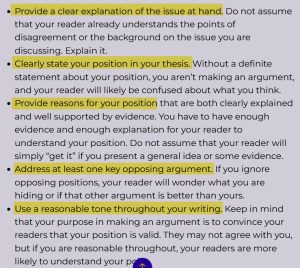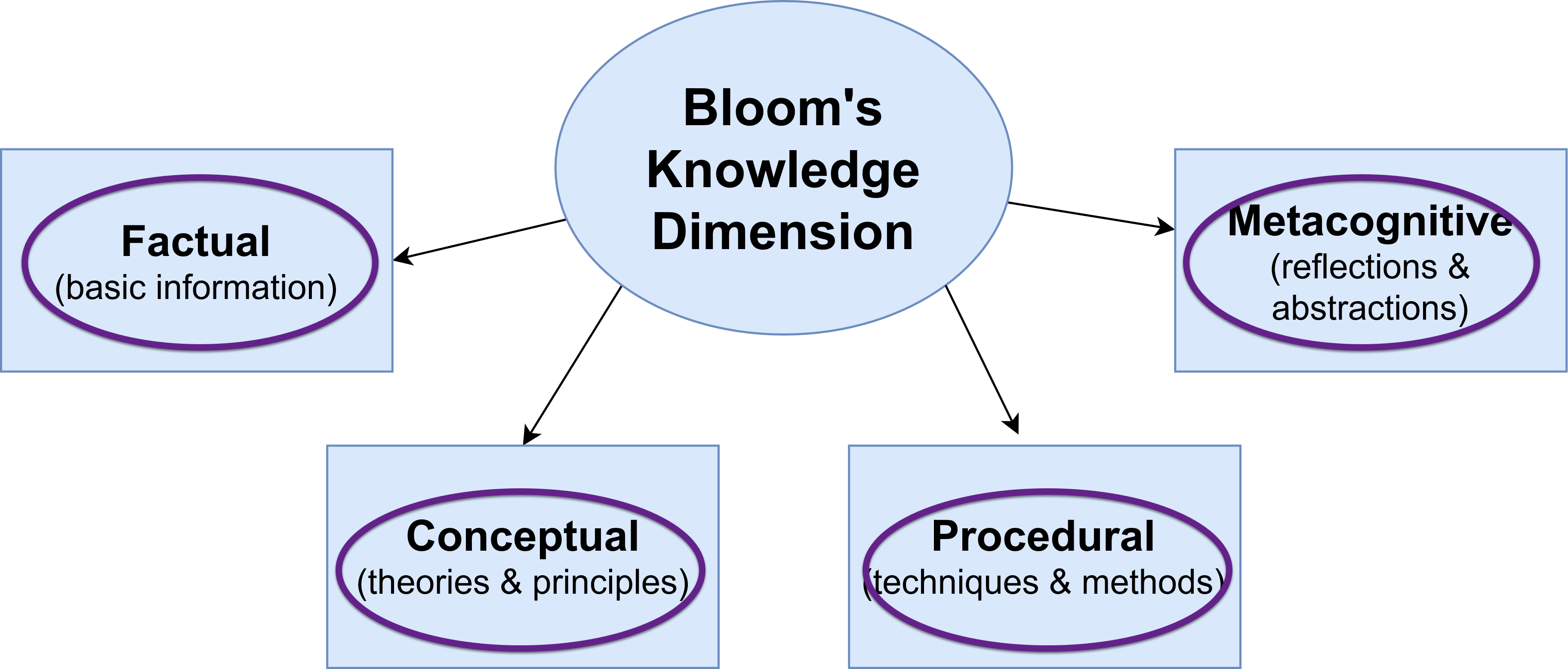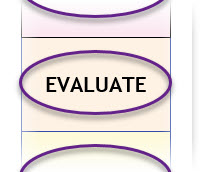Examining Sample Assignment 2: Position Paper
Let’s examine another, more advanced assignment, still from a first-year writing class. As with the previous example, I have left out some of the irrelevant particulars, but otherwise the assignment is complete. For a little context, this is an assignment given late in the term after students have explored writing conventions in the natural and social sciences.
| Assignment | Make an argument (take a position) on a controversial issue in U.S. society. |
| Audience | Other researchers in the humanities interested in the issue you are addressing |
| Sources | ProCon.org AND at least one additional reputable and relevant web source |
| Length | 1200-1500 words (4-5 pages) |
Unlike the natural sciences and the social sciences where objectivity is a goal, the humanities look specifically at the ways in which people make meaning. Research in the humanities thus involves looking at values, investments, and reasoning, among other things. Meanings are not objective, but that does not mean that all positions are equally valuable. Researchers in the humanities not only work to understand how people make meaning, but they also evaluate those meanings according to a range of criteria depending on the particular discipline. In this assignment, you’ll be analyzing the logic and support that people use to make a claim and support a position, and you’ll use your analysis to take a position of your own.
Choosing and Researching a Topic
Think about issues in our society where reasonable, rational people disagree. The possibilities are myriad, but for this assignment, I’m asking you to choose one from ProCon.org. Choose one in which you are interested, but do not choose any of the archived topics from that site (archived topics are not currently active and their information is out-of-date).
Read the information on ProCon.org carefully, paying particular attention to the kinds of logic and evidence that are used to support each side in a controversy. While you likely already have a position on the topic you have chosen, pay particular attention to the arguments that you find most convincing and the ones you find least convincing on both sides. Why does one point make more sense than another? You’ll be doing this kind of analysis in your paper.
You will supplement the information on this site with information from another source, one of your choosing from the web. Given that your issue is a current subject of debate in our society, the web can be an excellent resource for information—if you know how to search effectively and evaluate what you find. In class we’ll talk about how to do this. Your source can either support your position or oppose it; that choice is yours.
Once you have selected at least one relevant and reputable source, you’ll want to read that piece carefully, too, again paying particular attention to the logic and evidence the source uses. This source will supplement what you find on ProCon.org.
Making an Argument
When you write a position paper, you are making an argument, also called making a claim. In order to successfully make an argument, you must do a number of things:
- Provide a clear explanation of the issue at hand. Do not assume that your reader already understands the points of disagreement or the background on the issue you are discussing. Explain it.
- Clearly state your position in your thesis. Without a definite statement about your position, you aren’t making an argument, and your reader will likely be confused about what you think.
- Provide reasons for your position that are both clearly explained and well supported by evidence. You have to have enough evidence and enough explanation for your reader to understand your position. Do not assume that your reader will simply “get it” if you present a general idea or some evidence.
- Address at least one key opposing argument. If you ignore opposing positions, your reader will wonder what you are hiding or if that other argument is better than yours.
- Use a reasonable tone throughout your writing. Keep in mind that your purpose in making an argument is to convince your readers that your position is valid. They may not agree with you, but if you are reasonable throughout, your readers are more likely to understand your point.
Like the experience-based theory critique, this kind of essay has no set structure, and in class we’ll talk about how to make organizational decisions about this material.
Evaluation
When I evaluate your position statement, I will be looking to see how well you have met the goals of this assignment. That is, I will be looking for how well you presented and supported your claim with both evidence and reasoning. In addition, I will be looking for how well you address counterarguments and the tone you have used. If all you do is assert that your position is right or if you take no clear position, your paper will not be successful.
In addition, your comparison will need to meet the general criteria of any good academic writing: a clear focus, logical and purposeful organization, strong use of supporting evidence, and thoughtful development of the ideas you are presenting. And it will need to be well written both stylistically and grammatically.
Examining the Verbs in Key Sentences
In this assignment, we have a few more key sentences that give us information about what we are supposed to do in this assignment.
The first statement (“Make an argument (take a position) on a controversial issue in U.S. society.”) isn’t really one of them. This sentence doesn’t help much unless we already know what it makes to make an argument in college. When I run into sentences like this, I make note of that sentence and then keep looking for guidance.
 We find some in the last sentence in the first paragraph:
We find some in the last sentence in the first paragraph:
In this assignment, you’ll be analyzing the logic and support that people use to make a claim and support a position, and you’ll use your analysis to take a position of your own.
The first part is reasonably clear: we are analyzing, and the first “use” refers to what other people do, not us.
The second “use” is a little more complex. We are supposed to use the analysis we have done in the first part to “take a position,” also referred to as “make an argument” in the opening description. Again, unless we already know how to make an argument, this one isn’t as clear, so again, I’ll hold onto this one but plan to come back.
 The section about “Choosing a Research Topic” gives us guidance on which topic to use for this assignment and about finding an additional source, and the second paragraph tells us a bit about how we are supposed to think about the reading that we are doing:
The section about “Choosing a Research Topic” gives us guidance on which topic to use for this assignment and about finding an additional source, and the second paragraph tells us a bit about how we are supposed to think about the reading that we are doing:
Read the information on ProCon.org carefully, paying particular attention to the kinds of logic and evidence that are used to support each side in a controversy. While you likely already have a position on the topic you have chosen, pay particular attention to the arguments that you find most convincing and the ones you find least convincing on both sides. Why does one point make more sense than another? You’ll be doing this kind of analysis in your paper.
The verbs are a little less helpful in this paragraph, but the verb phrase “pay attention” helps us focus (“pay” by itself doesn’t make sense as the verb; this is an idiom, so we need the whole phrase). We can see that we are supposed to read all of our sources for the logic and evidence they use, and think about why we find some positions more convincing than others.
The section “Making an Argument” is actually much more helpful (as we might expect) because it explicitly tells us what we have to do in order to make an argument. We can see this in the verbs that begin each of the bullet points:

- Provide a clear explanation of the issue at hand.
- Clearly state your position in your thesis.
- Provide reasons for your position….
- Address at least one key opposing argument.
- Use a reasonable tone throughout your writing.
That looks like a blueprint.
Applying Bloom
Once again, let’s summarize the tasks in this assignment:
- Read and understand the kinds of logic and evidence used by both sides in arguments around a controversial issue.
- Explain that issue to our audience, including both sides (although we can emphasize the position we favor in our explanation because we only have to include one opposing argument).
- Take a position about that issue and explain our reasons for taking that position.
- Be sensible in our language use, not overly emotional.
Before jumping into the next section, take what you know about the task in the sample assignment and see which types of knowledge and which cognitive processes you believe the assignment is looking for.
After you read the rest of this chapter, decide whether or not you agree with my analysis.
Kinds of Cognitive Processes
To determine the kinds of cognitive tasks, again, let’s look at the verbs and again, let’s walk up the list of cognitive tasks.
As with most writing tasks in college, the assignment isn’t asking us to remember because we can reference our sources.
 We are being asked to understand because we have to explain the sides of the argument. We also need to understand procedural knowledge – how logic and evidence are used in the arguments that we are reading.
We are being asked to understand because we have to explain the sides of the argument. We also need to understand procedural knowledge – how logic and evidence are used in the arguments that we are reading.
This assignment asks us to apply the knowledge that we have gained about logic and evidence in our own argument, but notice that this task is implicit rather than explicit in the assignment. Direct application would ask us to use rhetorical principles like ethos, logos, and pathos to support a position, but that’s not what this assignment asks for. This assignment asks us to use our knowledge of how the sides make their arguments as we make our own.
Similarly, while we are doing some analysis—breaking the argument down into logic and types of evidence—this work is not the focus of this assignment. We will have to do some of this type of thinking, but only in the service of explaining our own position.
On the other hand, evaluating is a key cognitive process in this assignment. We are being asked to make a claim and support that claim with logic and evidence from our sources. Choosing a side (or even arguing for the merits of both sides) is making a judgement about which position is better. Notice that evaluation on the grid relies on “criteria and standards.” In other words, part of evaluating is articulating why we value what we value.
This assignment also asks us to create because we are expected to explain our own position and reasoning. We are not simply reporting someone else’s ideas and agreeing or disagreeing with those (though there may be some of that in our work). Articulating our own ideas is a creative act—albeit not as obviously creative as writing something like a poem or short story.
To summarize, this assignment asks us primarily to evaluate, but also to understand, apply, analyze, and create.
Kinds of Knowledge
Using our understanding what we need to discuss, we can use Bloom’s to help us understand the kinds of knowledge we need to demonstrate.
 Just as with the previous assignment, we’re going to have summarize; in this case, though, we’re summarizing the opposing arguments involved in an issue. Some of the knowledge we’ll be working with will be factual because we are simply reporting information and ideas held by others. But some will be conceptual, since we have to explain the differences between the sides.
Just as with the previous assignment, we’re going to have summarize; in this case, though, we’re summarizing the opposing arguments involved in an issue. Some of the knowledge we’ll be working with will be factual because we are simply reporting information and ideas held by others. But some will be conceptual, since we have to explain the differences between the sides.
We’re also looking at procedural knowledge when we examine the kinds of logic and evidence that the different sides use in their arguments. In this case, the procedure isn’t what we normally think of (e.g., how to make our own argument) but rather understanding how someone else has made one.
And finally, there is an element of metacognitive knowledge here. When the assignment asks us to think about why we are convinced by some arguments, the professor is asking us to reflect on the basis for our judgments when we think about the merits of someone’s position.
So, for this assignment, we are using all four types of knowledge in Bloom’s Taxonomy.
Notice that most of our guidance about the kinds of knowledge we’re using comes in the section when the professor explains our sources and how we’re supposed to use them. This is true for many writing assignments in college, since many of them require that we use sources.
Putting It Together
This assignment is more complex than the previous one. It’s asking us to use all four kinds of knowledge and all but one of the cognitive processes. But part of the trick for doing this assignment well is to pay attention to the emphasis put on these elements.
 Of the types of knowledge, conceptual and procedural appear to be most important. Yes, we need to relay factual information from the various positions, but it’s more important that we understand how those positions use logic and evidence so that we can apply those to our own position.
Of the types of knowledge, conceptual and procedural appear to be most important. Yes, we need to relay factual information from the various positions, but it’s more important that we understand how those positions use logic and evidence so that we can apply those to our own position.
 Evaluating is the most important cognitive process when making arguments. Arguments require constant judgment and justification, which in turn require that we evaluate sources, the ways in which sources are used, and logical statements and implications, among other elements. We have to be able to analyze and create to make a successful argument, too. But if we don’t do the evaluative work, our argument could be seen as baseless and without merit.
Evaluating is the most important cognitive process when making arguments. Arguments require constant judgment and justification, which in turn require that we evaluate sources, the ways in which sources are used, and logical statements and implications, among other elements. We have to be able to analyze and create to make a successful argument, too. But if we don’t do the evaluative work, our argument could be seen as baseless and without merit.
A usual or customary way of doing something. In writing, the term is most commonly applied to grammar and citation.
A group of words that has an established meaning in a culture or language that doesn't necessarily reflect the combination of the individual words.
Concepts used to explain how persuasion works, particularly in oral and written language.

